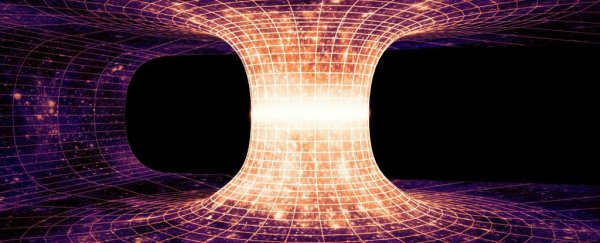One of the most fundamental tenets of modern physics is that in a perfect vacuum - a place entirely devoid of matter - no friction can possibly exist, because empty space cannot exert a force on objects travelling through it.
But despite the conventional wisdom, physicists in the UK discovered that a decaying atom travelling through a complete vacuum would experience a friction-like force, and now they've figured out how this reinforces - rather than breaks - Einstein's theory of general relativity.
"We spent ages searching for the mistake in the calculation and spent even more time exploring other strange effects until we found this (rather simple) solution," one of the team, Matthias Sonnleitner from the University of Glasgow told Lisa Zyga at Phys.org.
Sonnleitner and his colleagues were performing calculations to predict the behaviour of a decaying atom moving through a perfect vacuum when they noticed something strange.
For years, physicists have known that a perfect vacuum cannot exert any forces on an atom, but it can still interact with it.
It's impossible for physicists to physically create a perfect void, because no amount of decontamination can guarantee that a stray atom hasn't crept in, but calculations have predicted that a theoretically perfect vacuum would actually be buzzing with its own strange energy, filled with 'virtual' particle-antiparticle pairs that pop in and out of existence.
This 'empty but not empty' description of a perfect vacuum stems from an aspect of quantum mechanics called Heisenberg's uncertainty principle, which states that countless virtual particles could theoretically be appearing and disappearing at random moments in the void.
These quantum shifts produce randomly fluctuating electric fields, and the Glasgow team's calculations describe how they could interact with an atom travelling through a vacuum, causing it to absorb energy and enter an excited state.
As the excited atom decays to a lower energy state, it emits a photon (or light particle) in a random direction.
When the team calculated what happens when a photon is emitted while the atom is moving in the opposite direction to the photon, they detected a friction-like force that appeared to result in a loss of velocity.
If true, this would violate the principle of relativity, because it implies that 'observers' of the behaviour would see the atom moving at different speeds depending on where they were in relation to the atom.
Sonnleitner told Tim Wogan at Physics World that the team spent "weeks questioning their sanity" before figuring out the answer, and it all came down to E = mc2.
They realised that as the moving atom decays to a lower energy state and emits a photon in a random direction, this causes it to lose a tiny amount of energy, which corresponds to a tiny amount of mass.
This tiny amount of mass is known as the mass defect, and as Lisa Zyga reports for Phys.org, it's an amount so tiny, it has never been measured in this context before.
"This is the mass in Einstein's famous equation E = mc2, which describes the amount of energy required to break up the nucleus of an atom into its protons and neutrons," says Zyga.
"This energy, called the 'internal binding energy', is regularly accounted for in nuclear physics, which deals with larger binding energies, but is typically considered negligible in the context of atom optics (the field here), because of the much lower energies."
When the researchers plugged this mass defect value into their calculations, using E = mc2 to solve it, they found that by losing a tiny bit of mass as it decays, the atom actually loses momentum, not velocity.
If we look at the relationship between friction, velocity, and momentum, instead of seeing friction result from a change in momentum due to a loss of velocity, the scientists actually detected a loss of momentum due to a tiny change in its mass. Its velocity remains constant, as it should.
So instead of violating relativity by indicating friction in the vacuum, the phenomenon results in something that the principles of relativity actually predict - the decrease in mass causes the atom to lose a tiny amount of momentum, just as predicted by the conservation of energy and momentum in special relativity.
"[W]e have shown that, yes, a decaying atom sees a force resembling friction," the team concludes in their paper. "However, this force is a change in momentum due to a change in internal mass energy, and is not connected to decelerated motion."
The team says the next step will be to see if the phenomenon occurs when an atom absorbs - rather than emits - a photon.
And maybe someone will use it to help explain another study that hinted at friction in a perfect vacuum - in a 2011 study, physicists proposed that a vacuum could actually have friction if there are more of those 'virtual' particles pushing up against a spinning object than there are moving in the same direction.
The jury's still out on that, but one thing's for sure - strange things really do happen in the void.
The study has been published in Physical Review Letters.
